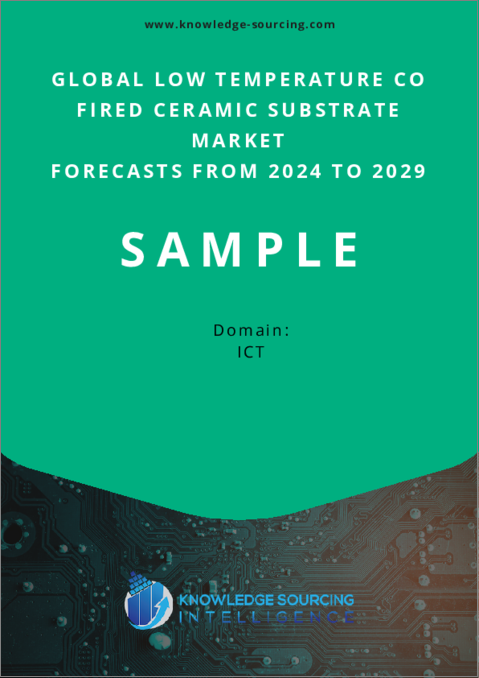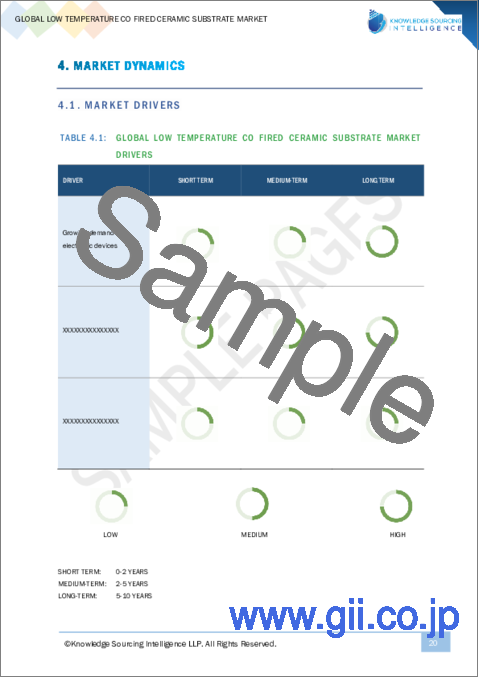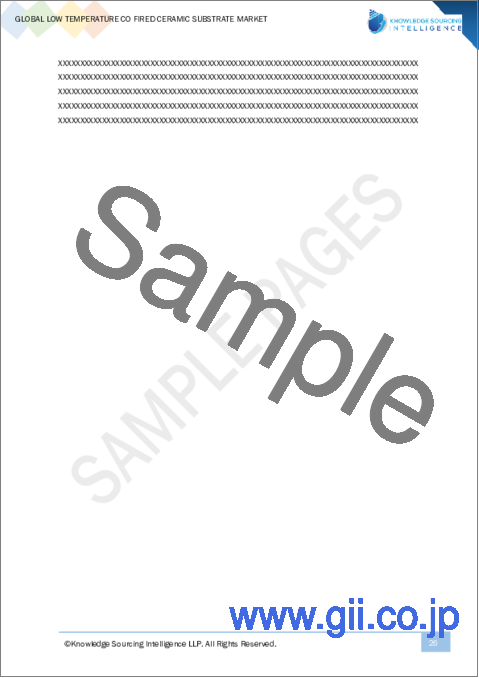|
|
市場調査レポート
商品コード
1456985
低温同時焼成セラミック基板の世界市場-2024年から2029年までの予測Global Low Temperature Co Fired Ceramic Substrate Market - Forecasts from 2024 to 2029 |
||||||
カスタマイズ可能
|
|||||||
| 低温同時焼成セラミック基板の世界市場-2024年から2029年までの予測 |
|
出版日: 2024年02月29日
発行: Knowledge Sourcing Intelligence
ページ情報: 英文 114 Pages
納期: 即日から翌営業日
|
- 全表示
- 概要
- 目次
世界の低温同時焼成セラミック基板市場はCAGR 7.87%で成長し、市場規模は2022年の86億8,000万米ドルから2029年には147億5,600万米ドルに達すると予測されています。
低温同時焼成セラミック(LTCC)は、銀や銅などの低抵抗金属導体を低い焼成温度(1,000℃以下)で同時焼成した多層ガラスセラミック基板です。小型・軽量で高速動作が可能な電子部品や基板が人気となっています。
市場の促進要因:
- さまざまな最終用途セグメントからの需要増。
通信、医療、自動車、工業、防衛、航空宇宙は、同時焼成セラミックの需要を牽引する最終用途産業の一つです。熱安定性の向上と化学的不活性という性質において、共焼成セラミックが従来のプリント回路基板より優れていることが、これらの業界がLTCCやHTCCを好む基本的な要因となっています。ハイエンド・コンピューティング・システムとナノ技術に対する需要の増加は、新しい産業の展望を開くと考えられます。
さまざまな利点
低損失の誘電体材料、組み込み受動部品の統合の容易さ、信頼性の高い多層機能といったLTCCの利点が、その需要を高めています。LTCCに使用されるセラミック材料は、標準的なPCB材料よりも損失正接が小さいです。これらの小型デバイスはLTCCを使用することで低コストで製造できるため、スマートフォン、パソコン、携帯機器、AR/VR用途で広く使用されている高周波モジュールへの需要が高まっています。
市場抑制要因
- 技術的問題
LTCCの性能に影響する収縮関連の問題とLTCCの低い熱伝導率が、予測期間中の低温同時焼成セラミック基板市場の拡大を阻害すると予想されます。
目次
第1章 イントロダクション
- 市場概要
- 市場の定義
- 調査範囲
- 市場セグメンテーション
- 通貨
- 前提条件
- 基準年と予測年のタイムライン
- 利害関係者にとっての主要メリット
第2章 調査手法
- 調査デザイン
- 調査プロセス
第3章 エグゼクティブサマリー
- 主要調査結果
- アナリストビュー
第4章 市場力学
- 市場促進要因
- 市場抑制要因
- ポーターのファイブフォース分析
- 業界バリューチェーン分析
- アナリストビュー
第5章 世界の低温同時焼成セラミック基板市場:タイプ別
- イントロダクション
- RFシステムレベルパッケージ
- 光電子パッケージ
- アレイパッケージ
- その他
第6章 世界の低温同時焼成セラミック基板市場:エンドユーザー産業別
- イントロダクション
- 家電
- 自動車
- 航空宇宙と軍事
- 通信
- その他
第7章 世界の低温同時焼成セラミック基板市場:地域別
- イントロダクション
- 北米
- 南米
- 欧州
- 中東・アフリカ
- アジア太平洋
第8章 競合環境と分析
- 主要企業と戦略分析
- 市場シェア分析
- 合併、買収、合意とコラボレーション
- 競合ダッシュボード
第9章 企業プロファイル
- Kyocera Corporation
- DowDuPont, Inc.
- Koa Speer Electronics, Inc.
- Murata Manufacturing Co., Ltd.
- Selmic Oy
- TDK Corporation
- Yokowo Co., Ltd.
- NGK SPARK PLUG CO., LTD.
- Adamant Namiki
- Apitech
The global low temperature co-fired ceramic substrate market is expected to grow at a CAGR of 7.87%, reaching a market size of US$14.756 billion in 2029 from US$8.68 billion in 2022.
Low-temperature co-fired Ceramics (LTCC) are multilayer glass-ceramic substrates that are co-fired with low resistance metal conductors at a low firing temperature (less than 1000°C) such as silver or copper. Electronic components and substrates that are compact, light, and deliver high speed have become popular.
Market Drivers:
- Rising demand from various end-use sectors-
Telecommunications, medical, automotive, industrial, defense, and aerospace are among the end-use industries driving demand for co-fired ceramics. The robust benefits profile that co-fired ceramics have over conventional printed circuit boards in terms of improved thermal stability and the nature of their chemical inactivity is a fundamental factor for these sectors preference for LTCC and HTCC. Increased demand for high-end computing systems and nanotechnology would open up new industry prospects.
Various advantages-
The advantages of LTCC, such as low-loss dielectric materials, ease of integrating embedded passive components, and reliable multilayer capabilities have increased their demand. Ceramic material utilized in LTCC has a lower loss tangent than standard PCB material. These small devices may be made using LTCC at a low cost, which has boosted demand for radiofrequency modules, which are widely used in smartphones, personal computers, portable devices, and AR/VR applications.
Market Restraint-
- Technical Issue-
Shrinkage-related problems affecting LTCC Performance and the low thermal conductivity of LTCC are expected to stifle the expansion of the Low-Temperature Co-fired ceramics substrate market in the projected period.
Market Segmentation:
By type, the global Low-Temperature Co-Fired ceramic substrate market is segmented into RF System Level Package, Optoelectronic Packages, Array Packages, and others. By end-user industry, the global Low-Temperature Co-Fired ceramic substrate market is segmented into consumer electronics, automotive, aerospace and military, telecommunication, and others. Due to the incorporation of sensors in many elements of cars, such as engines and power transmissions, the automotive segment holds a significant share. The consumer electronics industry has been also employing LTCC technology due to miniaturization, causing smaller electronic circuit boards to overheat.
Geographical segments:
The Asia-Pacific market is expected to the significant growth in demand for electronic devices, combined with technological developments and improvements in electronics. The country has a large number of market participants at each stage of the supply chain and has been spending heavily on new inventions and research and development. During the projected period, North America is also expected to account for a significant portion of the global market. The expansion of the electronic and automotive industries and R&D investments in North America is a major driver of the low-temperature co-fired ceramic (LTCC) substrate industry.
Market Developments:
- March 2023- TMY Technology Inc. (TMYTEK) and Celanese collaborated to showcase an innovative Ultra-Low Size, Weight, and Power (SWaP) Electronically Steered Antenna (ESA) solution featuring Antenna-on-Chip (AoC) technology at Satellite 2023. TMYTEK, a leading provider of millimeter-wave solutions, joined forces with Celanese, a global chemical and specialty materials company, to unveil their latest advancement. The dual-polarization AoC technology was crafted using Micromax(R) GreenTape(TM) low-temperature co-fired ceramic (LTCC).
Market Segmentation:
By Type
- RF System Level Package
- Optoelectronic Package
- Array Package
- Others
By End-User Industry
- Consumer Electronics
- Automotive
- Aerospace and Military
- Telecommunication
- Others
By Geography
- North America
- USA
- Canada
- Mexico
- South America
- Brazil
- Argentina
- Others
- Europe
- UK
- Germany
- France
- Others
- Middle East and Africa
- Saudi Arabia
- Israel
- Others
- Asia Pacific
- China
- Japan
- India
- South Korea
- Taiwan
- Indonesia
- Others
TABLE OF CONTENTS
1. INTRODUCTION
- 1.1. Market Overview
- 1.2. Market Definition
- 1.3. Scope of the Study
- 1.4. Market Segmentation
- 1.5. Currency
- 1.6. Assumptions
- 1.7. Base, and Forecast Years Timeline
- 1.8. Key benefits to the stakeholder
2. RESEARCH METHODOLOGY
- 2.1. Research Design
- 2.2. Research Process
3. EXECUTIVE SUMMARY
- 3.1. Key Findings
- 3.2. Analyst View
4. MARKET DYNAMICS
- 4.1. Market Drivers
- 4.2. Market Restraints
- 4.3. Porter's Five Forces Analysis
- 4.3.1. Bargaining Power of Suppliers
- 4.3.2. Bargaining Power of Buyers
- 4.3.3. Threat of New Entrants
- 4.3.4. Threat of Substitutes
- 4.3.5. Competitive Rivalry in the Industry
- 4.4. Industry Value Chain Analysis
- 4.5. Analyst View
5. GLOBAL LOW-TEMPERATURE CO-FIRED CERAMIC SUBSTRATE MARKET BY TYPE
- 5.1. Introduction
- 5.2. RF System Level Package
- 5.2.1. Market opportunities and trends
- 5.2.2. Growth prospects
- 5.2.3. Geographic lucrativeness
- 5.3. Optoelectronic Package
- 5.3.1. Market opportunities and trends
- 5.3.2. Growth prospects
- 5.3.3. Geographic lucrativeness
- 5.4. Array Package
- 5.4.1. Market opportunities and trends
- 5.4.2. Growth prospects
- 5.4.3. Geographic lucrativeness
- 5.5. Others
- 5.5.1. Market opportunities and trends
- 5.5.2. Growth prospects
- 5.5.3. Geographic lucrativeness
6. GLOBAL LOW-TEMPERATURE CO-FIRED CERAMIC SUBSTRATE MARKET BY END-USER INDUSTRY
- 6.1. Introduction
- 6.2. Consumer Electronics
- 6.2.1. Market opportunities and trends
- 6.2.2. Growth prospects
- 6.2.3. Geographic lucrativeness
- 6.3. Automotive
- 6.3.1. Market opportunities and trends
- 6.3.2. Growth prospects
- 6.3.3. Geographic lucrativeness
- 6.4. Aerospace and Military
- 6.4.1. Market opportunities and trends
- 6.4.2. Growth prospects
- 6.4.3. Geographic lucrativeness
- 6.5. Telecommunication
- 6.5.1. Market opportunities and trends
- 6.5.2. Growth prospects
- 6.5.3. Geographic lucrativeness
- 6.6. Others
- 6.6.1. Market opportunities and trends
- 6.6.2. Growth prospects
- 6.6.3. Geographic lucrativeness
7. GLOBAL LOW-TEMPERATURE CO-FIRED CERAMIC SUBSTRATE MARKET BY GEOGRAPHY
- 7.1. Introduction
- 7.2. North America
- 7.2.1. By Type
- 7.2.2. By End-user
- 7.2.3. By Country
- 7.2.3.1. United States
- 7.2.3.1.1. Market Trends and Opportunities
- 7.2.3.1.2. Growth Prospects
- 7.2.3.2. Canada
- 7.2.3.2.1. Market Trends and Opportunities
- 7.2.3.2.2. Growth Prospects
- 7.2.3.3. Mexico
- 7.2.3.3.1. Market Trends and Opportunities
- 7.2.3.3.2. Growth Prospects
- 7.2.3.1. United States
- 7.3. South America
- 7.3.1. By Type
- 7.3.2. By End-user
- 7.3.3. By Country
- 7.3.3.1. Brazil
- 7.3.3.1.1. Market Trends and Opportunities
- 7.3.3.1.2. Growth Prospects
- 7.3.3.2. Argentina
- 7.3.3.2.1. Market Trends and Opportunities
- 7.3.3.2.2. Growth Prospects
- 7.3.3.3. Others
- 7.3.3.3.1. Market Trends and Opportunities
- 7.3.3.3.2. Growth Prospects
- 7.3.3.1. Brazil
- 7.4. Europe
- 7.4.1. By Type
- 7.4.2. By End-user
- 7.4.3. By Country
- 7.4.3.1. Germany
- 7.4.3.1.1. Market Trends and Opportunities
- 7.4.3.1.2. Growth Prospects
- 7.4.3.2. France
- 7.4.3.2.1. Market Trends and Opportunities
- 7.4.3.2.2. Growth Prospects
- 7.4.3.3. United Kingdom
- 7.4.3.3.1. Market Trends and Opportunities
- 7.4.3.3.2. Growth Prospects
- 7.4.3.4. Others
- 7.4.3.4.1. Market Trends and Opportunities
- 7.4.3.4.2. Growth Prospects
- 7.4.3.1. Germany
- 7.5. Middle East and Africa
- 7.5.1. By Type
- 7.5.2. By End-user
- 7.5.3. By Country
- 7.5.3.1. Saudi Arabia
- 7.5.3.1.1. Market Trends and Opportunities
- 7.5.3.1.2. Growth Prospects
- 7.5.3.2. Israel
- 7.5.3.2.1. Market Trends and Opportunities
- 7.5.3.2.2. Growth Prospects
- 7.5.3.3. Others
- 7.5.3.3.1. Market Trends and Opportunities
- 7.5.3.3.2. Growth Prospects
- 7.5.3.1. Saudi Arabia
- 7.6. Asia Pacific
- 7.6.1. By Type
- 7.6.2. By End-user
- 7.6.3. By Country
- 7.6.3.1. China
- 7.6.3.1.1. Market Trends and Opportunities
- 7.6.3.1.2. Growth Prospects
- 7.6.3.2. Japan
- 7.6.3.2.1. Market Trends and Opportunities
- 7.6.3.2.2. Growth Prospects
- 7.6.3.3. India
- 7.6.3.3.1. Market Trends and Opportunities
- 7.6.3.3.2. Growth Prospects
- 7.6.3.4. South Korea
- 7.6.3.4.1. Market Trends and Opportunities
- 7.6.3.4.2. Growth Prospects
- 7.6.3.5. Indonesia
- 7.6.3.5.1. Market Trends and Opportunities
- 7.6.3.5.2. Growth Prospects
- 7.6.3.6. Taiwan
- 7.6.3.6.1. Market Trends and Opportunities
- 7.6.3.6.2. Growth Prospects
- 7.6.3.7. Others
- 7.6.3.7.1. Market Trends and Opportunities
- 7.6.3.7.2. Growth Prospects
- 7.6.3.1. China
8. COMPETITIVE ENVIRONMENT AND ANALYSIS
- 8.1. Major Players and Strategy Analysis
- 8.2. Market Share Analysis
- 8.3. Mergers, Acquisition, Agreements, and Collaborations
- 8.4. Competitive Dashboard
9. COMPANY PROFILES
- 9.1. Kyocera Corporation
- 9.2. DowDuPont, Inc.
- 9.3. Koa Speer Electronics, Inc.
- 9.4. Murata Manufacturing Co., Ltd.
- 9.5. Selmic Oy
- 9.6. TDK Corporation
- 9.7. Yokowo Co., Ltd.
- 9.8. NGK SPARK PLUG CO., LTD.
- 9.9. Adamant Namiki
- 9.10. Apitech






